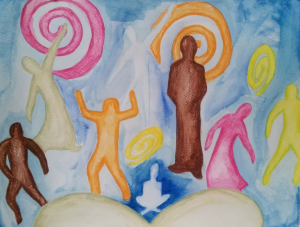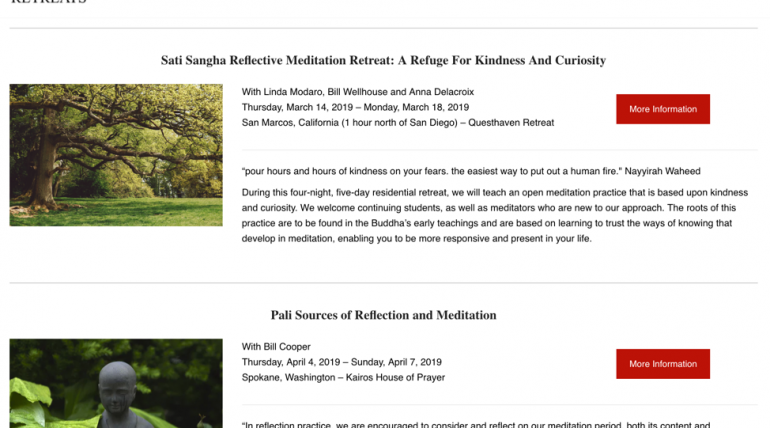This post is an abridged version of an article published in the 2017 Reflective Meditation eJournal, which features two pieces of Erin’s artwork. I hope you take the time to dive into her images and words; for just like a meditation sitting you may be surprised at what arises for you, and what stays with you afterwards.
–Linda
In Erin’s words: one piece is a self-portrait, of a 20-something-year-old Erin, casually sitting, while journaling behind white bars (or perhaps they are not bars?). The other piece depicts a meditator sitting on top of a hill (or a heart), with images of other people scattered in the background (or foreground?).
 Personally, I am not a fan of naming my art pieces for several reasons. I have found that my pieces come to mean different things to me at different times. The meaning behind an art piece may mean one thing to me when I first create it, and then evolve to mean something different years later as my perspective changes. My process of artistic creation is similar to my process of meditation in this respect; I may start an art piece with one intention, and through the experience of creating, my intentions and views shift, and the art piece ends up being quite different than I initially envisioned. Much like a meditation sitting, when I follow my interest in the creative process, I am often surprised by what I find, and the “finished product” is rarely—if ever—what I have imagined at the outset. So, I find that the experience of naming an art piece is somewhat limiting and often inaccurate—it binds the “official meaning” of my art to a certain time, place, perspective, or self, and I would rather have my art remain more fluid and adaptable.
Personally, I am not a fan of naming my art pieces for several reasons. I have found that my pieces come to mean different things to me at different times. The meaning behind an art piece may mean one thing to me when I first create it, and then evolve to mean something different years later as my perspective changes. My process of artistic creation is similar to my process of meditation in this respect; I may start an art piece with one intention, and through the experience of creating, my intentions and views shift, and the art piece ends up being quite different than I initially envisioned. Much like a meditation sitting, when I follow my interest in the creative process, I am often surprised by what I find, and the “finished product” is rarely—if ever—what I have imagined at the outset. So, I find that the experience of naming an art piece is somewhat limiting and often inaccurate—it binds the “official meaning” of my art to a certain time, place, perspective, or self, and I would rather have my art remain more fluid and adaptable.
 In the art piece above with the image of myself journaling, I am sitting behind blank, white bar-like objects. As I created the piece, I loved the imagery of me writing and creating something (e.g. journaling—an act which I consider to be demonstrative of and requiring a certain amount of freedom) in the context of something which limits freedom. As I created this piece, I was wrestling with what it means to be truly free (while feeling trapped), or what it means to feel as if you are free (while failing to see the bars which entrap you).
In the art piece above with the image of myself journaling, I am sitting behind blank, white bar-like objects. As I created the piece, I loved the imagery of me writing and creating something (e.g. journaling—an act which I consider to be demonstrative of and requiring a certain amount of freedom) in the context of something which limits freedom. As I created this piece, I was wrestling with what it means to be truly free (while feeling trapped), or what it means to feel as if you are free (while failing to see the bars which entrap you).
If I had to choose a name for the second piece (the one featuring the meditator on a hill with many colorful figures behind them), I might call it, “The stillness of meditation.” I would call it this humorously, ironically, because I have never experienced meditation to be truly still or unmoving. My most calm sittings usually have something else go on within them at some point. Within this piece, I was toying with the humorous juxtaposition of how still my body can be when I sit to meditate (and how calm and serene I may look to an observer), while inside my mind, there is no telling what I am experiencing. I could be experiencing a calm, samadhi state. I could be following my breath or very focused on the sensation of my glutes touching my cushion. I could be vigorously engaged in organizing the background section of my literature review for my dissertation. I could be reliving an old, painful memory, imagining a future self, or experiencing something that seems more like a vision or a dream. I could be rehearsing a difficult conversation or problem-solving something repeatedly, because each iteration seems to be forgotten as soon as it occurs. I could have lost sight and sense of my “self” all together and be experiencing some kind of expansive, connected sensation, wherein I am tumbling or twirling ever so slightly in a spacious place. Or, I could be practicing metta, wrestling with some concept of the dharma, or stumbling upon dharma without even knowing it.
As I have engaged in writing this reflection, I am struck by the many similarities that exist between the creative processes I engage in while drawing, and the creative processes I engage in while meditating. It is no coincidence that you could re-read this reflection and interchange the words “art” and “meditation” frequently throughout it. The values that I have cultivated in my meditation practice are reflected in my art (e.g. following my interest and curiosity, appreciation for complexity, gentle engagement, the value in the unknown), though they did not originate in my meditation practice. Similarly, the values I express in my art are also evident in my meditation and in my teaching of meditation. Just as I do not like to name pieces and give them an “official title,” I hesitate to delve too much into interpretation of another person’s meditation experience. Rather, I seek to probe and understand what meaning they have made of it. Similarly, just as I view my art and the viewer’s interpretation of my art as an act of artistic co-creation, so too, have I come to understand my own taking up of the dharma through meditative processes. For instance, I may hear a dharma talk from a teacher, sit with those concepts, reflect on them during meditation, and then report my meditation to a teacher, who then inquires about my meditative experiences, and potentially alludes back to the same (or different) dharmic concepts. When (and if) I then come to a new understanding or insight of the dharma as a result of those experiences, this view has in effect, been co-created, or perhaps more accurately, dependently arisen from those experiences, through the careful cultivation of a teacher’s care and wisdom, the complex conditions of my inner world, and my own taking up of the concepts.


